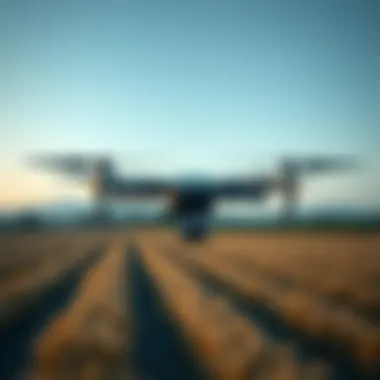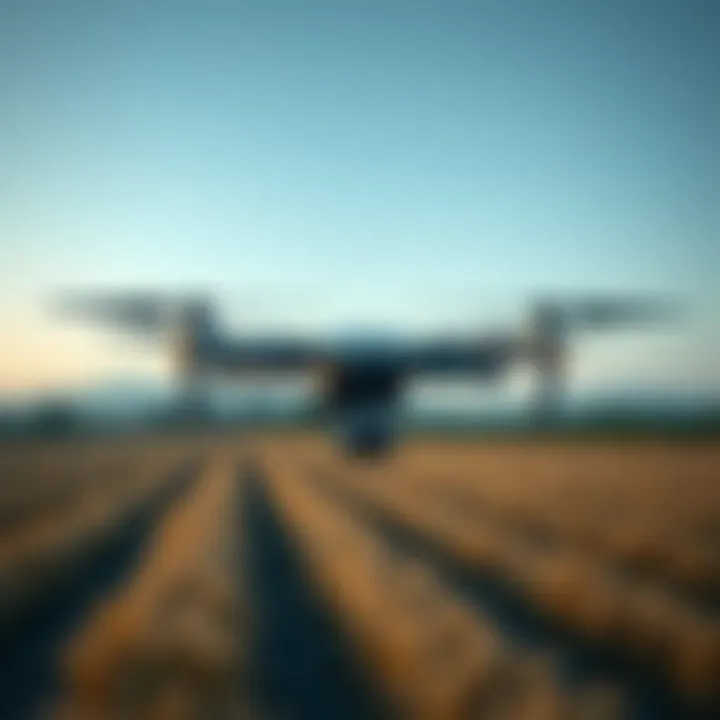Understanding Drone Liability Coverage Challenges


Intro
As drones increasingly take to the skies in both personal and commercial settings, the topic of liability coverage has taken center stage. Understanding the nuances of drone liability insurance is crucial for anyone looking to operate these aerial vehicles safely. Whether you’re a hobbyist capturing breathtaking landscapes or a business utilizing drones for deliveries, the implications of drone liability coverage can’t be overstated.
Why does liability coverage matter? In short, the risk involved in drone operations is not to be taken lightly. From property damage caused by malfunctioning equipment to potential personal injury claims arising from an accident, the stakes are high. It’s imperative to grasp not only the types of coverage available but also the factors that determine your specific needs with this insurance.
In this article, we will unravel the complexities surrounding drone liability coverage. We’ll provide detailed insights into the types of coverage you might encounter, the various factors that can affect your coverage requirements, and the legal considerations that every drone operator should be aware of. By the end of this guide, our aim is to empower readers—from individual users to commercial operators—with the knowledge needed to make informed decisions about liability insurance. Let's get this conversation off the ground!
Understanding Drone Liability Coverage
In the landscape of rapidly evolving drone technology, understanding the intricacies of drone liability coverage is pivotal. As individuals and businesses embrace the use of drones for various applications, from aerial photography to agricultural monitoring, the need for robust liability protections grows. This section of the article elucidates the critical aspects of drone liability coverage, helping readers grasp its significance in securing their investments and ensuring compliance with legal obligations.
Definition of Drone Liability Coverage
Drone liability coverage refers to insurance policies specifically designed to protect drone operators against claims related to property damage, personal injury, and other liabilities arising from drone operations. This type of coverage is vital in shielding operators from the financial repercussions of mishaps, which can happen all too readily in unpredictable environments. For instance, if a drone inadvertently crashes into someone's property or injures an individual, without proper coverage, the operator might face substantial out-of-pocket costs that could lead to severe financial strain or even bankruptcy.
Importance of Liability Insurance
The importance of liability insurance cannot be overstated, especially in the realm of drone operations. Unfortunately, many individuals overlook this necessity until it’s too late. Having drone liability coverage offers peace of mind, allowing operators to focus on their work without the constant worry of potential damages. Moreover, as drone regulations become more stringent, evidence of liability insurance is often a requirement in many jurisdictions. Failure to secure adequate coverage not only risks financial setbacks but could also result in legal penalties.
Types of Drone Liability Coverage
Understanding the different types of drone liability coverage available is essential for choosing the right plan.
-#### General Liability Insurance General liability insurance often serves as the foundation for many drone operators. This type of coverage protects against third-party claims for bodily injury and property damage that may arise during drone operations. It’s beneficial because it tends to cover a broad range of potential risks. A unique feature of this insurance is its ability to encompass coverage for non-owned drones, which is advantageous for operators who may rent or borrow drones temporarily. However, it may not cover specific business activities or unique operation scenarios, necessitating additional coverage options.
-#### Commercial Liability Insurance For those using drones as a part of a business, commercial liability insurance is essential. This coverage applies to businesses that utilize drones in their operations, safeguarding them against a range of liabilities specific to commercial use, including damages occurring during work-related flight operations. The defining characteristic of this insurance is its tailored nature; it can be adjusted based on the specific risks associated with the particular industry, such as construction or photography. One must note, though, that the cost of commercial liability insurance can be higher compared to general policies, but the investment proves worthwhile given the potential risks and liabilities involved in commercial flights.
-#### Product Liability Insurance If a drone is designed, manufactured, or sold by a company, product liability insurance becomes crucial. This insurance protects manufacturers against claims stemming from defects in the product that may lead to injury or property damage. A key aspect of product liability coverage is its comprehensiveness; it includes various forms of claims such as those involving design defects or insufficient instructions. However, because this insurance is often complex and tailored, understanding the finer details can be challenging. Operators must carefully evaluate policy terms, as limitations may exist regarding specific types of claims or products covered.
Knowing the right type of coverage for your drone operations is like having a smart map. It guides you through potential risks and helps avoid legal pitfalls.
By grasping the definitions and importance of these various types of coverage, drone operators can make informed choices suited to their specific needs and operational contexts. A thoughtful approach towards liability insurance not only safeguards against unforeseen incidents but also establishes a foundation of trust with clients and partners alike.
Growing Demand for Drones
The increasing demand for drones is revolutionizing industries across the globe, marking a significant shift in how business operations are conducted. Whether it’s delivering packages, conducting real-time surveillance, or providing aerial photography, drones have firmly nested themselves into numerous sectors. This growth necessitates a closer examination of the associated liability coverage, as businesses and individuals look to safeguard against potential risks. Drone liability insurance is of paramount importance as it not only provides financial protection but also promotes compliance with regulatory requirements, ensuring that operators can continue innovating without the looming threat of legal repercussions.
Industries Adopting Drone Technology
Real Estate
The real estate sector has embraced drone technology as a game-changer that enhances property marketing. Drones allow for stunning aerial views that showcase a property’s surroundings, which can be an enticing proposition for potential buyers. This aspect of real estate can greatly benefit sellers and agents by providing a unique perspective that traditional photography simply can’t replicate.
However, this technological advancement doesn’t come without its challenges. Real estate agents must ensure they have adequate liability coverage to protect against accidents that may occur during drone flights, particularly in populated areas. The crucial characteristic here is the high stakes involved; a crash could not only damage property but also injure individuals, leading to costly lawsuits.
Construction
The construction industry is another significant adopter of drone technology. Drones provide precise data collection for site surveying and monitoring project progress. They streamline workflows by offering real-time insights that can save both time and money. By capturing high-resolution images, drones help project managers identify issues early on, thus reducing delays and rework.
Yet, the complexity of construction sites means that liability risks are heightened. Drones can malfunction, leading to potential harm to workers or damage to expensive equipment. A robust liability insurance plan tailored for construction operations can cushion against these risks, enabling teams to operate efficiently with peace of mind.
Agriculture
In agriculture, drones are proving invaluable for crop monitoring and precision farming. Farmers use drones to gather essential data about crop health, soil analysis, and irrigation needs, which allows for more informed management decisions. This technology not only boosts productivity but also aids in resource conservation, making it a smart investment for modern agriculture.


Nevertheless, like any technology, drones bring along potential risks. Agricultural drone operators need to be aware of weather conditions and other environmental factors that could lead to accidents or crop damage. As a result, having comprehensive liability coverage tailored to agricultural use is vital, ensuring that operators are safeguarded while pushing farming into the future.
Emergency Services
Drones have also carved out a niche in emergency services, where they are utilized for search and rescue missions, delivering medical supplies, and assessing disaster scenarios. They provide invaluable insights quickly and efficiently, often reaching areas that are difficult for personnel to access. The use of drones in these critical situations enhances response times, significantly impacting outcomes for those in peril.
However, the stakes are incredibly high in emergency services. A drone malfunction during a critical mission could jeopardize lives. Thus, individuals and organizations operating drones in these contexts must secure specialized liability coverage that accommodates the complexities of emergency operations.
Rise of Commercial Drone Use
The surge in commercial drone use is indicative of an evolving landscape where businesses are increasingly relying on these advanced technologies to streamline operations. This rapid growth is underpinned by regulatory advancements and greater public acceptance. As industries continue to integrate drones into their workflows, the need for comprehensive liability coverage becomes even more critical.
As we'll explore in the next section, understanding the unique risks associated with each operational context is essential for selecting appropriate liability insurance. Individual needs, location of operation, and intended use are central to determining the optimal coverage strategy for drone operators.
Factors Influencing Coverage Needs
In today’s landscape, understanding the factors influencing coverage needs is paramount for drone operators, whether they are hobbyists or commercial users. This section sheds light on key elements that determine the optimal insurance coverage for different users, helping them navigate potential risks effectively.
Type and Size of Drone
The type of drone being used plays a significant role in determining insurance needs. Drones vary in functionality, from simple toy-like models to complex commercial-grade equipment.
For example, a small recreational drone, typically weighing less than two kilograms, might not pose a huge risk, thus requiring minimal liability coverage. In contrast, larger drones designed for commercial use can weigh over 25 kilograms and, when operated, can cause significant damage if an accident occurs. Therefore, operators should assess the specific characteristics of their drones, including:
- Weight and size: Heavier drones often have higher risk and potential for damage.
- Capabilities: Drones equipped with cameras for real estate may require different coverage than those used for agricultural purposes.
Ultimately, understanding these distinctions enables operators to choose liability insurance that suits their specific drone characteristics, reducing their legal exposure.
Usage Purpose
The purpose for which a drone is used significantly impacts the needed coverage. The distinction between commercial and recreational usage is particularly crucial.
Commercial vs. Recreational
Commercial drone usage usually involves activities that generate income, such as aerial photography, surveying, or inspections. In contrast, recreational use might simply include flying for fun or leisure.
The key characteristic of commercial operations is that they typically entail higher stakes. In these scenarios, operators face not only potential harm to third parties but also risks regarding their professional reputation. These attributes mean that commercial drone users often seek higher coverage limits, given the increased risks associated with their operations. On the other hand, recreational flyers may opt for basic plans that cater to common mishaps associated with personal use.
A unique feature of commercial usage is the potential liability in the context of contracts and client relationships. For instance, if a drone operator fails to meet the expectations set by a client, legal liability could arise. Whereas for recreational users, liability claims may stem primarily from accidents involving other people or property.
- Advantages of Commercial Use: Potentially higher income through specialized services, access to broader insurance options.
- Disadvantages: Higher premiums, increased regulations, and stricter operational guidelines.
Location of Operation
The geographical area where drones are operated can drastically affect insurance considerations. Different regions have varying regulations and risks.
For instance, flying drones in urban environments typically presents greater risks due to higher population density and potential for property damage. Conversely, rural areas might offer more lenient regulations and fewer risks, yet operators still need to factor in the specific risks related to wildlife or unforeseen obstacles.
When evaluating location risks, consider aspects like:
- Local weather conditions: Bad weather can cause accidents or equipment malfunctions.
- Airspace regulations: Certain areas may have heavier restrictions on drone flights, requiring specialized insurance.
- Proximity to sensitive areas: Locations near schools, hospitals, or government buildings often require additional coverage due to increased liability.
Understanding these factors provides a clearer picture of the potential risks and coverage requirements, tailored to each operator's situation.
Legal Considerations for Drone Operators
Understanding the legal landscape surrounding drone operations is crucial for operators, whether they're hobbyists or professionals. As drones gain popularity, knowing the laws and regulations that govern their use is not merely beneficial; it's essential. Regulations can vary from one area to another, necessitating a deep awareness of local rules alongside national guidelines. This ensures compliance and protects operators from potential liabilities that might arise during drone operations.


Regulations Affecting Drone Use
Federal Aviation Administration (FAA) Guidelines
The Federal Aviation Administration, or FAA, lays down the foundational regulations for drone operation in the United States. These guidelines are crucial for drone operators since they set the permissible heights, no-fly zones, and operational protocols that must be followed. One significant aspect of the FAA's contribution is the requirement of remote pilot certification for commercial drone use, which presents a standard that operators must meet.
A key characteristic of these guidelines is their aim to integrate drones into the national airspace safely. This is beneficial because it provides operators with a structured framework, ensuring that everyone's on the same page regarding safety and responsibility. However, these regulations can also be seen as a double-edged sword; while they promote safety, they may limit the operational freedom of drone pilots.
Unique features of the FAA guidelines include a series of safety checks, such as pre-flight inspections and maintenance logs, which add an extra layer of accountability and transparency in drone operations. Though this system can seem cumbersome, its advantages far outweigh the disadvantages, especially when considering the potential legal costs of accidents or violations.
Local Laws and Regulations
Besides federal guidelines, local laws can significantly impact how drones can be used in various areas. While some states and cities have specific restrictions—such as prohibiting drone flights over private property or public gatherings—these regulations often reflect community standards and safety concerns. Understanding local laws reigns vital for operators wishing to avoid fines or legal action.
A key characteristic of local regulations which sets them apart from federal ones is the focus on community standards. This localized approach allows for finer control over drone usage, making it a valuable choice for this article. However, the caveat here is that it can lead to confusion for operators who move between jurisdictions, as the rules might be different from one mile to the next.
An interesting feature of local regulations is that they can sometimes be more restrictive than FAA guidelines, which may be frustrating for operators. This extra layer, while protective for residents, can pose limitations for those eager to leverage drones for various innovative uses. Understanding these intricate layers of regulation is essential, as it helps ensure that drone operators are clear about their rights and responsibilities when flying.
Legal Liabilities of Drone Operators
Drone operators face considerable legal liabilities that stem from accidents, property damage, or privacy violations. When something goes amiss during a drone flight, the operator might find themselves in a legal quagmire. Knowing the scope of these liabilities is crucial for effective liability coverage.
Drones can inadvertently invade personal or private spaces, causing unease among individuals who feel their privacy is compromised. This can lead to lawsuits that range from nuisance claims to more serious legal action. Thus, understanding the nuances of potential liabilities is a key part of responsible drone operation.
In essence, being well-versed in both federal and local regulations and understanding the potential legal liabilities provides drone operators with a comprehensive toolkit for navigating the complexities of drone use. It not only empowers them to operate safely but also shields them from unforeseen legal consequences.
Risks Associated with Drone Operations
Understanding the risks associated with drone operations is critical, especially as the use of these aircraft grows rapidly across different sectors. Drones, while immensely beneficial, bring a unique set of complexities that can lead to legal troubles or financial liabilities. Identifying and addressing these risks helps in making better decisions in terms of liability coverage. Without proper precautions, the repercussions of accidents, privacy breaches, and cybersecurity threats can be significant, both operationally and financially.
Accidents and Collisions
When it comes to drone operations, accidents and collisions are perhaps the most visible risks. Whether it's a crash into a building, vehicle, or even a person, the potential for harm is real. In urban environments, the probability of collisions increases significantly because of dense overhead structures and busy airspace. The stakes aren’t just whether a drone can dodge a lamppost—it’s about the financial impact of any damage caused.
Drones can be difficult to control, especially under adverse weather conditions or technical malfunctions. Untrained operators might inadvertently fly them into restricted airspace, leading to more profound implications, including fines or even criminal charges. Operators need to not only understand the mechanics of flying but also grasp the wider implications of their actions. Estimating risks properly allows for better policy selection.
"Proper training and adherence to regulations can minimize the risk of accidents, ultimately leading to better coverage and peace of mind."
Privacy Concerns
Another significant risk pertains to privacy issues. Drones equipped with cameras can inadvertently or deliberately infringe on personal privacy, leading to legal disputes or claims of harassment. For instance, imagine a drone flying over a private backyard, recording footage without the owner’s consent. This not only breaches ethical norms but also legal ones, as many jurisdictions have strict laws regarding surveillance and privacy.
In today’s world, where data breaches and privacy invasions dominate headlines, it is vital for drone operators to be aware of these concerns. Compliance with regulations surrounding privacy is paramount. Operators should incorporate privacy awareness into their flight operations, which may involve notifying individuals before capturing any footage or ensuring that no personal data is collected inadvertently. Understanding these privacy risks is essential to select the right liability insurance.
Cybersecurity Risks
Last but not least, the rise of drones opens new doors for cybersecurity threats. As the technology becomes more advanced, vulnerabilities can be exploited by hackers who might take control of a drone, reroute its path, or steal sensitive information collected during a flight. Recent incidents show how drones can be hijacked, causing not only monetary loss but also trust issues with clients relying on drone services.
Protecting against cybersecurity threats is not merely about having the latest software; it's about building a robust framework that encompasses all aspects of drone operations—including pre-flight checks and ongoing monitoring of systems. Operators may need to invest in specialized cybersecurity policies to mitigate these risks adequately, thus preventing potential data breaches and reinforcing customer trust.
Choosing the Right Drone Liability Coverage
Selecting the appropriate drone liability coverage is a cornerstone for anyone engaged in drone operations—whether they are hobbyists or commercial entities. With drone technology gaining traction across a multitude of industries, understanding how to choose the right coverage is more critical than ever. Picking the wrong plan can leave operators unprotected against potential legal fallout resulting from accidents or errors.
This section aims to clarify processes and highlight decision-making elements that govern the choice of drone liability coverage.
Assessing Individual Needs


First things first—assessing your specific needs is essential. Individual requirements can vary significantly depending on what kind of operations you plan to undertake. For instance, recreational users should consider basic liability coverage as their operations typically involve fewer risks than commercial users who may be liable for extensive damages.
When evaluating your needs, you might want to ask yourself:
- What types of drones do I operate? The size and capability of the drone can significantly influence insurance costs and coverage options.
- Where do I fly? For example, flying in urban areas may present different risks compared to rural or controlled environments.
- What is the intended purpose? Different uses—like agricultural surveillance versus aerial photography—carry unique risks that should dictate the type and extent of your coverage.
Ultimately, understanding your operational context allows you to identify coverage gaps and choose a plan that meets your unique requirements.
Evaluating Insurance Providers
Next up is evaluating insurance providers. This part of the process has as much importance as assessing your personal needs. Not all insurance companies are created equal, and some are better suited for drone operators than others. When choosing a provider, you'll want to focus on two main areas: reputation and trustworthiness, along with policy terms and conditions.
Reputation and Trustworthiness
When it comes to reputation and trustworthiness, these two go hand-in-hand. An insurer's history in handling claims can give you valuable insight into how they operate and whether you can depend on them in a time of need. A provider that has built a solid reputation often means they've been able to meet the expectations of their clients.
An important aspect is the user reviews. Positive feedback from current or past clients indicates a provider's reliability. On the flip side, a company with numerous complaints may raise red flags.
The trustworthiness of an insurance provider can be tracked through its financial stability. Ratings from independent agencies can assess whether the company has the resources to cover claims effectively.
Policy Terms and Conditions
Now we get to the nitty-gritty: policy terms and conditions. This aspect is crucial as it dictates how you’ll be covered in various situations. Every policy has its fine print!
A key characteristic to consider is the scope of coverage, which defines what is included and what is excluded. Commercial operations may require more detailed coverage compared to recreational uses, so make sure to check if the policy provides ample coverage for potential liabilities.
Remember to keep an eye on any exclusions that may apply, as these can result in unpleasant surprises when claims are filed. Certain policies might exclude coverage for specific activities or locations, leaving operators vulnerable.
It’s best to sit down with the policy document and read through it thoroughly, ideally discussing any confusing terms with a knowledgeable representative. Paying attention to fine details will save you heartache later on.
In the fast-evolving world of drones, having the right insurance isn’t just a safeguard; it’s a smart investment that pays off when unexpected situations arise.
Choosing the right drone liability coverage is more than a mere formality; it can push you toward a successful operation or lead to significant financial risk. With the proper assessment of your needs and careful evaluation of insurance providers, you will be well on your way to securing your assets and operations effectively.
Policy Customization Options
Drone operators often find themselves face-to-face with various insurance policies that can feel like navigating a maze. It is crucial to understand that policy customization options can make a tangible difference in protecting investments and ensuring compliance with laws. In this landscape of rapidly evolving drone technology, the ability to adapt insurance coverage to meet individual needs becomes increasingly important.
Selecting the right coverage is not merely about ticking boxes; it’s about assessing risk and seeking solutions tailored to specific operational requirements. Customizing a policy can provide several advantages, including enhanced protection against unique hazards associated with drone operations, potential for cost savings through adjustments in coverage, and peace of mind knowing that all bases are covered.
When operators sit down with insurance professionals, they should prioritize discussing customization options. This should incorporate add-ons and any endorsements appropriate for the particular type of drone use—whether commercial, recreational, or even specialized sectors like filmmaking or agriculture.
Policy customization isn’t just beneficial; it’s a strategic necessity in today’s drone operating environment.
Add-Ons and Endorsements
The terms add-ons and endorsements often float around insurance discussions, but many do not fully grasp their significance. Essentially, an add-on is an additional coverage feature that can be tacked onto a base policy, while an endorsement modifies an existing policy to either enhance or limit coverage.
Some noteworthy add-ons worth considering include:
- Coverage for Payload or Equipment Damage: If a drone is transporting expensive gear or tools, additional coverage can safeguard against loss or damage, which would otherwise come out of pocket.
- International Coverage: For operators traveling beyond U.S. borders, having insurance that extends to international operations is critical, as many domestic policies do not cover overseas activities.
- Pilot Training Coverage: If hiring or training new pilots, this coverage will protect against liabilities linked to training operations.
Make sure to discuss such add-ons with an insurance broker, as they can identify what options best align with individual operational risks.
Tailoring Coverage to Specific Operations
Every drone operation has different demands and faces its challenges. This makes tailoring coverage a paramount step in achieving solid liability protection. For instance, a construction site drone flies in a chaotic environment with significant obstacles, from heavy machinery to workers on the ground, and needs different coverage than, say, a drone used for real estate photography.
Operators should ask themselves:
- What is my primary focus? Is it agricultural monitoring, aerial photography, or infrastructure inspection? Each operational focus comes with its own risks and needs.
- What regulatory environment am I operating in? Understanding local laws can dictate necessity for certain endorsements and coverage structures.
- What are the potential liabilities? Analyze situations where accidents could happen, such as drone failure during flight, and what coverage would mitigate those specific risks.
By asking such critical questions and customizing liability insurance, operators position themselves well to safeguard against potential financial repercussions—all while promoting compliance with applicable regulations. Each decision made regarding customization serves not only as a protective measure but also as a step towards more efficient and responsible drone operations, ensuring long-term success in the ever-evolving aerial landscape.















